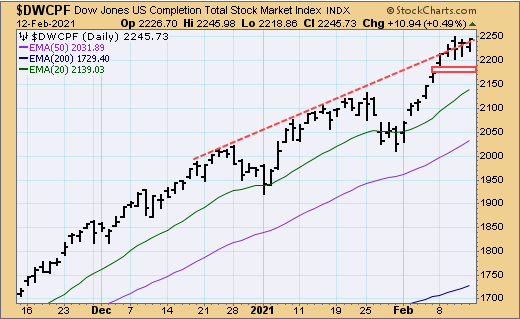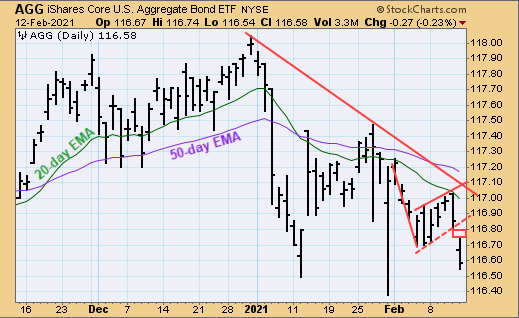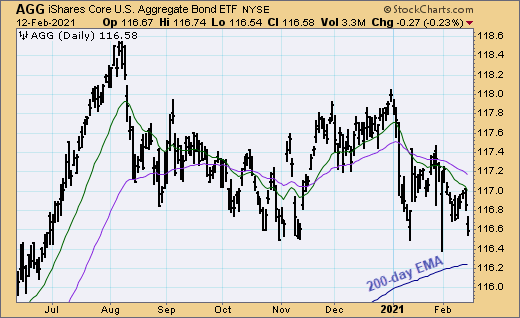A week full of 'choppy' actions ends with a late rally to put stocks at new all time highs. Friday was the S&P 500's 10th record close in 2021. For most of the week we saw a lack on conviction in stock gains. Jerome Powell did his best to reassure investors that monetary stimulus and low rates will not go away anytime soon. Still the market couldn't decide on a direction throughout the week and it was a late rally following a mid-day pull back to push the indices to new highs.
It is growing all too obvious stock prices have risen too pricey and continue to outpace their true valuations. Market participants know the market is set for a set back and the fear is that will take place in a day's or a few day's action leaving it hard for many to escape at a moments notice. Its something that happens maybe once every year or few years. Obviously the last quick pull back was last February so its relatively fresh in memory. The market doesn't usually comply with the obvious and could rally for months before a pull back occurs; all along growing the potential magnitude of a justified pull back. This becomes a conundrum for the investors who must decide whether to wait out a correction on the sidelines all the while losing out on all the gains produced in the mean time, or tack on those gains while they are easy and adjust when necessary. The later is hard to TSP participants who get two trades a month and they don't pick their price but rather their day. Again I must say there is no obvious answer and the path you choose depends on your investing personality and your ability (time) to afford a significant cut in your retirement savings.
Despite already being overvalued, stocks do have the short-term advantage thanks to fiscal and monetary stimulus and the promise of vaccines. But there will be long-term consequences. This is an argument for the ages and the bears have been wrong since 2009 despite the artificial stimulus increasing.
Small caps once again outperformed the stock funds. The S-fund was up 3.24% for the week; more than double the C-fund's return. Bonds slipped Friday to turn its weekly gains to losses. The F-fund was down 0.12% for the week.

Here are the weekly, monthly, and annual TSP fund returns for the week ending February 5:

The SPY (S&P 500 / C-fund) was up early in the week but the action was turbulent and the gains were even given up intraday Wednesday. A late rally Friday gave the index a decent boost and lifted the index to 1.28 % in gains for the week. Overhead resistance has slowed the momentum of the index but the index has still added 6.01% in gains over the last two weeks.

The Dow Completion Index (S-fund) broke above its resistance Tuesday. The index chopped back and forth between the rising resistance line for the week eventually closing about even with it. The end result was a 3.24% gain for the week to outperform the TSP funds for the week.

EFA (EAFE Index / I-fund) found and traded between the highs of January mid-week but a rally Friday put the index into new territory with some room. An open gap was left behind to start the week. The I-fund gained 2.08% for the week to outperform the more popular C-fund.

AGG (Bonds / F-fund) closed Wednesday with a 0.27% gain for the week. The next day the index opened at its 20-daty EMA and slipped from there losing half of its weekly gains in the day. Friday the index broke below its bear flag after gapping down and slipped into negative territory where it finally ended the week with a 0.12% loss. This was the only loss for the TSP funds.

The bond market is at the lower end of its trading range in months and is approaching prices it hasn't traded at since last July.

Good luck and thanks for reading. We will be back here next week with another TSP Wrap Up. You can read our daily market commentary at the Market Comments page. If you need more help deciding what to do with your account, perhaps one of our Premium Services can help.
Thomas A Crowley
www.tsptalk.com
Facebook | Twitter
The legal stuff: This information is for educational purposes only! This is not advice or a recommendation. We do not give investment advice. Do not act on this data. Do not buy, sell or trade the funds mentioned herein based on this information. We may trade these funds differently than discussed above. We use additional methods and strategies to determine fund positions.
It is growing all too obvious stock prices have risen too pricey and continue to outpace their true valuations. Market participants know the market is set for a set back and the fear is that will take place in a day's or a few day's action leaving it hard for many to escape at a moments notice. Its something that happens maybe once every year or few years. Obviously the last quick pull back was last February so its relatively fresh in memory. The market doesn't usually comply with the obvious and could rally for months before a pull back occurs; all along growing the potential magnitude of a justified pull back. This becomes a conundrum for the investors who must decide whether to wait out a correction on the sidelines all the while losing out on all the gains produced in the mean time, or tack on those gains while they are easy and adjust when necessary. The later is hard to TSP participants who get two trades a month and they don't pick their price but rather their day. Again I must say there is no obvious answer and the path you choose depends on your investing personality and your ability (time) to afford a significant cut in your retirement savings.
Despite already being overvalued, stocks do have the short-term advantage thanks to fiscal and monetary stimulus and the promise of vaccines. But there will be long-term consequences. This is an argument for the ages and the bears have been wrong since 2009 despite the artificial stimulus increasing.
Small caps once again outperformed the stock funds. The S-fund was up 3.24% for the week; more than double the C-fund's return. Bonds slipped Friday to turn its weekly gains to losses. The F-fund was down 0.12% for the week.

Here are the weekly, monthly, and annual TSP fund returns for the week ending February 5:

The SPY (S&P 500 / C-fund) was up early in the week but the action was turbulent and the gains were even given up intraday Wednesday. A late rally Friday gave the index a decent boost and lifted the index to 1.28 % in gains for the week. Overhead resistance has slowed the momentum of the index but the index has still added 6.01% in gains over the last two weeks.

The Dow Completion Index (S-fund) broke above its resistance Tuesday. The index chopped back and forth between the rising resistance line for the week eventually closing about even with it. The end result was a 3.24% gain for the week to outperform the TSP funds for the week.

EFA (EAFE Index / I-fund) found and traded between the highs of January mid-week but a rally Friday put the index into new territory with some room. An open gap was left behind to start the week. The I-fund gained 2.08% for the week to outperform the more popular C-fund.

AGG (Bonds / F-fund) closed Wednesday with a 0.27% gain for the week. The next day the index opened at its 20-daty EMA and slipped from there losing half of its weekly gains in the day. Friday the index broke below its bear flag after gapping down and slipped into negative territory where it finally ended the week with a 0.12% loss. This was the only loss for the TSP funds.

The bond market is at the lower end of its trading range in months and is approaching prices it hasn't traded at since last July.

Good luck and thanks for reading. We will be back here next week with another TSP Wrap Up. You can read our daily market commentary at the Market Comments page. If you need more help deciding what to do with your account, perhaps one of our Premium Services can help.
Thomas A Crowley
www.tsptalk.com
Facebook | Twitter
The legal stuff: This information is for educational purposes only! This is not advice or a recommendation. We do not give investment advice. Do not act on this data. Do not buy, sell or trade the funds mentioned herein based on this information. We may trade these funds differently than discussed above. We use additional methods and strategies to determine fund positions.
